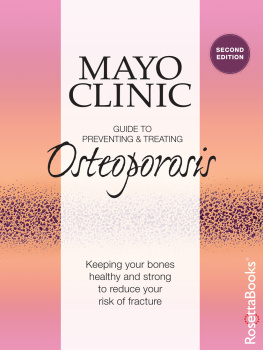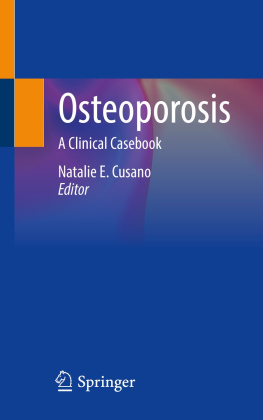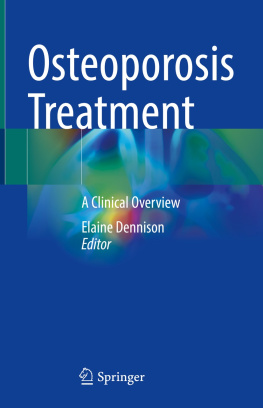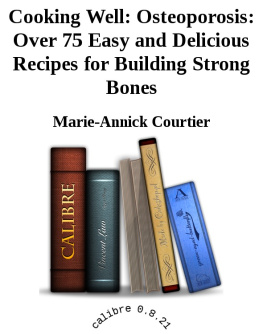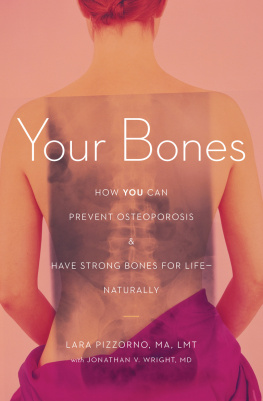The Osteoporosis Handbook
The Osteoporosis Handbook
The Comprehensive Guide to
Prevention and Treatment
Sydney Lou Bonnick, M.D., F.A.C.P.
Institute for Womens Health
Texas Womans University

Dedicated to my family
Copyright 1994, 1997, 2000 by Sydney Lou Bonnick, M.D., F.A.C.P.
All rights reserved.
No part of this book may be reproduced in any form
without written permission from the publisher.
Published by Taylor Trade Publishing
A Member of the Rowman & Littlefield Publishing Group
4501 Forbes Blvd., Suite 200
Lanham, Maryland 20706
Estraderm (estradiol transdermal system), mentioned in , The 50 Most Commonly Asked Questions, and the Glossary, is a registered trademark of Ciba-Geigy Corporation.
Illustrations appearing on are reprinted by permission of the Mayo Foundation, from: Exercise and Physical Therapy, M. Sinaki. In Osteoporosis: Etiology, Diagnosis, and Management. B. L. Riggs and L. J. Melton III, Jr., eds. Raven Press, New York, 1988.
Library of Congress Cataloging-in-Publication Data
Bonnick, Sydney Lou.
The osteoporosis handbook : every womans guide to prevention and treatment / Sydney Lou Bonnick.
p. cm.
Includes index.
ISBN: 0-87833-259-6
1. OsteoporosisPopular works. 2. WomenDiseasesPopular works. I. Title
RC931.073B66 1994
616.7'16dc20
93-31038
CIP
Printed in the United States of America
Distributed by National Book Network
Contents
Foreword
It is a pleasure to write the foreword for a practical handbook that will benefit every woman. Dr. Sydney Bonnick is an authority on osteoporosis, who has spent many years treating and assessing women for bone loss and the predisposition to bone loss. For the last five years she has been the director of osteoporosis services at the Cooper Clinic (a world-renowned preventive medicine center). Recently, she has accepted an appointment as a research professor at the Center for Research on Womens Health at Texas Womans University. Dr. Bonnick also chairs the American Medical Womens Associations Committee on Osteoporosis, is a frequent lecturer on this condition, and is a good friend.
National interest in osteoporosis has developed on several fronts during the last two decades. In the 1970s it was noted that astronauts lost bone while in space. Weightlessness was recognized as a prime cause of osteoporosis, just as it had been seen in polio victims confined to iron lung respirators two decades earlier. In the effort to protect the astronauts and improve the nations space program, research was directed at the prevention and alleviation of osteoporosis. Thus the interest in this predominantly elderly womans disease began as an effort to protect some of our most vigorous people at the timeastronauts, who were predominantly younger men.
In more recent years, we have realized that women in the United States receive health care that is based on less adequate research than the care men receive. Many women physicians, after receiving the good medical education and training that the American system offers, found their training did not sufficiently prepare them to meet the health needs of the women they saw in clinical practice. Many took additional courses, participated in informal preceptorships, and did further reading to fill the void in their knowledge. The public became better acquainted with gender bias in research when a congressional committee investigated the practices of the National Institutes of Health in 1989. As a result of the investigation, the Office for Research in Womens Health was created. A woman, Dr. Bernadine Healy, was appointed as director of the NIH and a massive scientific study, called the Womens Health Initiative, was launched. Osteoporosis is a prime concern of the Womens Health Initiative.
Womens health also became a focus of a new curriculum attempting to teach primary care doctors (internists, gynecologists, and family practitioners) the skills and information needed to meet womens health needs. The American Medical Womens Associations Advanced Curriculum on Womens Health is a continuing medical education course given for physicians of every specialty. Efforts are made to incorporate this curriculum into medical schools, so that all physicians will provide better care to women within their specialities. In addition, the National Council on Womens Health is conducting seminars and courses to increase womens knowledge of their risks for disease and strengths as women.
Women live longer than men, but the disabilities of old age, especially osteoporosis and its attendant fractures, can make the last decades torturous. Womens health and the publics outlay of funds for the care of the elderly would benefit enormously if the prevention of osteoporosis was instituted effectively and universally. Dr. Bonnicks book provides the information necessary for women to protect themselves from this disease; it should reach the hands of every woman. While the final assessment of a womans propensity for osteoporosis rests with her personal physician, Dr. Bonnicks book provides an impetus for women to seek better personal health care. The Osteoporosis Handbook will help women become better partners in their care.
Lila A. Wallis, M.D., F.A.C.P. founding president of the National Council on Womens Health May 1994
Acknowledgments
Many different companies graciously provided me with photographs that illustrate the medications and equipment used in the prevention and treatment of osteoporosis. All of the companies understood that the use of their photographs was not intended as a specific endorsement of their product, nor do any of these companies specifically endorse this book. Our mutual goal was to provide women with the information and direction they need to prevent and treat osteoporosis. I would like to thank Peter Mazer of Hologic, Inc., Joyce Paucek of Norland Medical Systems, Jody Carmean and Brad Harrington of Lunar Corp., Christian Wulff of Osteometer MediTech, Daniel Michaeli of Schick, Nat Hines of Novartis Pharmaceuticals, Jack Douglass and Ashoke Mitra of Procter & Gamble Pharmaceuticals, Jeri Gardner of Eli Lilly Pharmaceuticals, and Melissa Billings of Merck and Co., Inc., all of whom were instrumental in helping me obtain the necessary materials for this book. I am also grateful to North Coast Medical for providing photographs of safety devices for the bath designed to reduce the risk of falling and to Cybex for providing photographs of their exercise equipment. I would also particularly like to thank Mr. Lonnie Yarbrough, R.Ph. for his invaluable assistance in preparing the section Estrogens Role in Osteoporosis and Mr. Jacob McBee for his assistance in creating many of the photographs used in this book.
I also owe a tremendous debt to many other dedicated professionals who willingly gave their time to help in the preparation of this manuscript. Dr. Robert Heaney at Creighton University, whose expertise in calcium nutrition and osteoporosis is known throughout the United States and abroad, was always available to discuss issues of calcium and osteoporosis with me in spite of considerable demands on his time. Dr. Barney Sanborn, professor and director of the Institute for Womens Health at Texas Womans University, patiently explained the nuances of strength training and exercise programs for women on many occasions. Phillip Walker, M.S.S., designed the basic concepts for the walking programs recommended in this book. His enthusiasm for exercise in the prevention of osteoporosis is contagious and his concern for the well-being of his patients is always admirable. Dr. Everett Smith of the University of Wisconsin shared his expertise in the field of osteoporosis and exercise. Georgia Kostas, M.P.H., R.D., assisted with the discussion of the role of calcium and other nutrients in the prevention and treatment of osteoporosis, as did Dr. Nancy DiMarco, professor, Texas Womans University. Lisa Baldwin of the U.S. Department of Agriculture and Ruth Carpenter of the Cooper Institute for Aerobics Research were also extremely helpful in providing information on the nutritional status of women in the United States.


